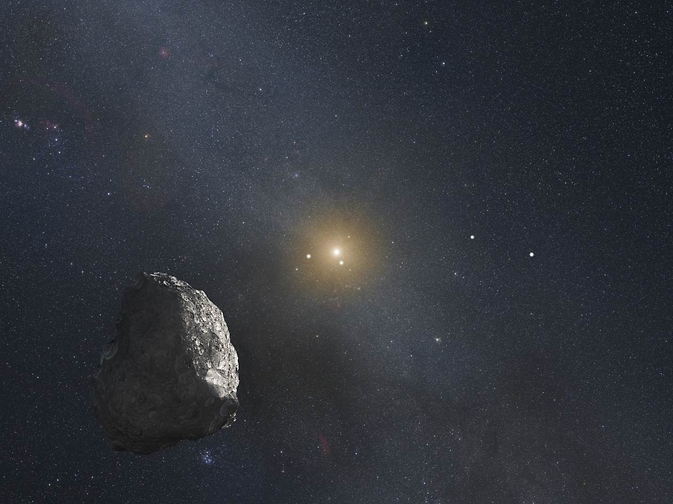The Kuiper Belt is a vast rim of primordial debris encircling our solar system. KBOs belong to a unique class of solar system objects that has never been visited by spacecraft and which contain clues to the origin of our solar system.
The Kuiper Belt objects are each about 10 times larger than typical comets, 1 to 2 percent of the size of Pluto. Unlike asteroids, Kuiper Belt objects have not been heated by the sun and are thought to represent a pristine, well preserved deep-freeze sample of what the outer solar system was like following its birth 4.6 billion years ago.

Artist’s impression of a Kuiper Belt object. Credit: NASA, ESA, and G. Bacon (STScI)
Hurtling across the solar system, the New Horizons spacecraft would reach the distance of 4 billion miles from the sun at its farthest point roughly three to four years after its July 2015 Pluto encounter.
The New Horizons team started to look for suitable Kuiper Belt objects in 2011 using some of the largest ground-based telescopes on Earth. They found several dozen but none was reachable within the fuel supply available aboard the New Horizons spacecraft.
“We started to get worried that we could not find anything suitable, even with Hubble, but in the end the space telescope came to the rescue,” said New Horizons science team member John Spencer of SwRI. “There was a huge sigh of relief when we found suitable KBOs; we are ‘over the moon’ about this detection.”
Following an initial proof of concept of the Hubble pilot observing program in June, the New Horizons Team was awarded telescope time by the Space Telescope Science Institute for a wider survey in July. When the search was completed in early September, the team identified one KBO that is considered “definitely reachable,” and two other potentially accessible KBOs that will require more tracking over several months to know whether they too are accessible by the New Horizons spacecraft.
This was a needle-in-haystack search for the New Horizons team because the elusive KBOs are extremely small, faint, and difficult to pick out against a myriad background of stars in the constellation Sagittarius, which is in the present direction of Pluto. The three KBOs identified each are a whopping 1 billion miles beyond Pluto. Two of the Kuiper Belt objects are estimated to be as large as 34 miles across, and the third is perhaps as small as 15 miles.
The New Horizons spacecraft, launched in 2006 from Florida, is the first mission in NASA’s New Frontiers Program. Once a NASA mission completes its prime mission, the agency conducts an extensive science and technical review to determine whether extended operations are warranted. The New Horizons team expects to submit such a proposal to NASA in late 2016 for an extended mission to fly by one of the newly identified Kuiper Belt objects. Accomplishing such a KBO flyby would substantially increase the science return from the New Horizons mission as laid out by the 2003 Planetary Science Decadal Survey.
Source: NASA





Comments